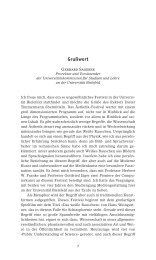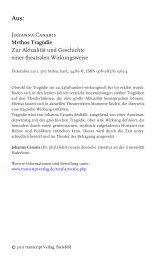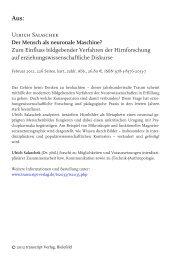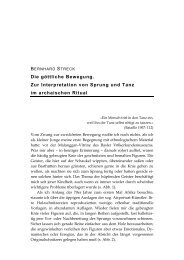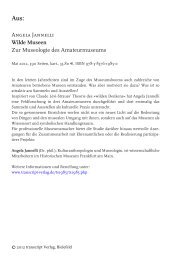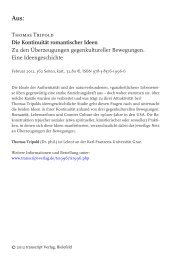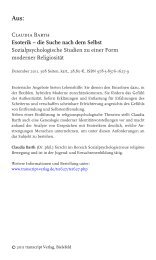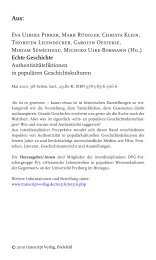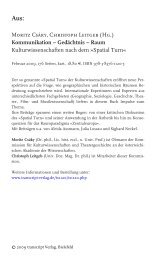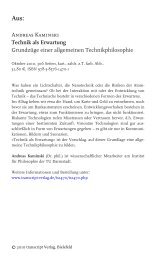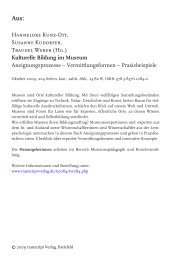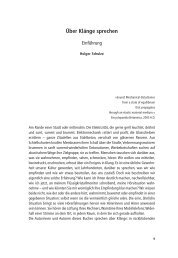Julia Straub (ed.) Paradoxes of Authenticity Studies on a Critical ...
Julia Straub (ed.) Paradoxes of Authenticity Studies on a Critical ...
Julia Straub (ed.) Paradoxes of Authenticity Studies on a Critical ...
You also want an ePaper? Increase the reach of your titles
YUMPU automatically turns print PDFs into web optimized ePapers that Google loves.
10 | JULIA STRAUB<br />
doesn’t break,’” he states (123, emphasis in the original). “‘[L]ike vile<br />
glass,’” he c<strong>on</strong>tinues, “‘It splits – if there is a split’” (123). Holding up<br />
the bowl and marvelling at its beauty, he p<strong>on</strong>ders “‘Where is the weak<br />
place?’” (124), before he and Charlotte decide not to buy the bowl and<br />
leave the shop (to embark <strong>on</strong> a life <str<strong>on</strong>g>of</str<strong>on</strong>g> marital unhappiness and extramarital<br />
c<strong>on</strong>solati<strong>on</strong>s).<br />
If authenticity had to be c<strong>on</strong>ceiv<str<strong>on</strong>g>ed</str<strong>on</strong>g> <str<strong>on</strong>g>of</str<strong>on</strong>g> as a material object, it would<br />
be a Jamesian golden bowl. It would attract passers-by, luring them<br />
back for sec<strong>on</strong>d or third looks, perhaps even tempting them to enter<br />
the shop. Eventually, they would refrain from buying the bowl since a<br />
closer inspecti<strong>on</strong> would reveal that it is split. A fragile object, though<br />
pleasing to the beholder, this bowl is a risky purchase. Similarly, authenticity<br />
is a c<strong>on</strong>cept that lost its innocence a l<strong>on</strong>g time ago; by menti<strong>on</strong>ing<br />
it, <strong>on</strong>e automatically feels compell<str<strong>on</strong>g>ed</str<strong>on</strong>g> to issue a caveat or two.<br />
Just like the split bowl, authenticity comes with a warning that <strong>on</strong>e<br />
should not buy into it without some good insurance. J<strong>on</strong>athan Culler<br />
formulat<str<strong>on</strong>g>ed</str<strong>on</strong>g> its crux back in the 1980s, and his dictum is so central that<br />
it is best plac<str<strong>on</strong>g>ed</str<strong>on</strong>g> as a motto for this volume. Once mark<str<strong>on</strong>g>ed</str<strong>on</strong>g> as authentic,<br />
the m<str<strong>on</strong>g>ed</str<strong>on</strong>g>iat<str<strong>on</strong>g>ed</str<strong>on</strong>g> character <str<strong>on</strong>g>of</str<strong>on</strong>g> the alleg<str<strong>on</strong>g>ed</str<strong>on</strong>g>ly authentic comes to the fore,<br />
spoiling the illusi<strong>on</strong> <str<strong>on</strong>g>of</str<strong>on</strong>g> the “unspoil<str<strong>on</strong>g>ed</str<strong>on</strong>g>,” as it were. Thirty odd years<br />
later, this c<strong>on</strong>tradicti<strong>on</strong> is as present and valid as ever. It is the double<br />
bind <str<strong>on</strong>g>of</str<strong>on</strong>g> the authentic – that it sends <str<strong>on</strong>g>of</str<strong>on</strong>g>f signals both <str<strong>on</strong>g>of</str<strong>on</strong>g> imm<str<strong>on</strong>g>ed</str<strong>on</strong>g>iacy and<br />
m<str<strong>on</strong>g>ed</str<strong>on</strong>g>iati<strong>on</strong>, genuineness and performance, sp<strong>on</strong>taneity and staging –<br />
that this collecti<strong>on</strong> <str<strong>on</strong>g>of</str<strong>on</strong>g> essays seeks to explore.<br />
Given the number <str<strong>on</strong>g>of</str<strong>on</strong>g> recent publicati<strong>on</strong>s <strong>on</strong> authenticity (to some<br />
<str<strong>on</strong>g>of</str<strong>on</strong>g> which I will return below), <strong>on</strong>e can argue that authenticity has<br />
gain<str<strong>on</strong>g>ed</str<strong>on</strong>g> momentum in literary and cultural studies as well as in relat<str<strong>on</strong>g>ed</str<strong>on</strong>g><br />
disciplines during the last decade or so. However, critics seem to handle<br />
it with a certain amount <str<strong>on</strong>g>of</str<strong>on</strong>g> unease. Theodor W. Adorno, who theoriz<str<strong>on</strong>g>ed</str<strong>on</strong>g><br />
its ‘split’ more than any other thinker in the twentieth century,<br />
declar<str<strong>on</strong>g>ed</str<strong>on</strong>g> authenticity – implying truthfulness, originality and singularity<br />
– to be estrang<str<strong>on</strong>g>ed</str<strong>on</strong>g> from our reality, a c<strong>on</strong>cept no l<strong>on</strong>ger to be harness<str<strong>on</strong>g>ed</str<strong>on</strong>g><br />
for discussi<strong>on</strong>s <str<strong>on</strong>g>of</str<strong>on</strong>g> the artwork and the status <str<strong>on</strong>g>of</str<strong>on</strong>g> art. Once entering<br />
mass producti<strong>on</strong>, he wrote in Minima Moralia, the work <str<strong>on</strong>g>of</str<strong>on</strong>g> art will<br />
dissimulate the traces <str<strong>on</strong>g>of</str<strong>on</strong>g> its own making, thereby evoking the impressi<strong>on</strong><br />
<str<strong>on</strong>g>of</str<strong>on</strong>g> perfecti<strong>on</strong> and, paradoxically, authenticity. The artist’s fingerprint<br />
will disappear from the canvas he held, or more generally speak-



